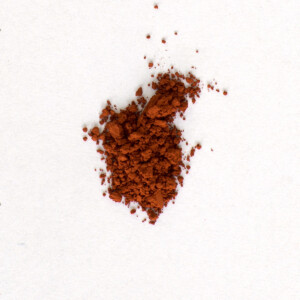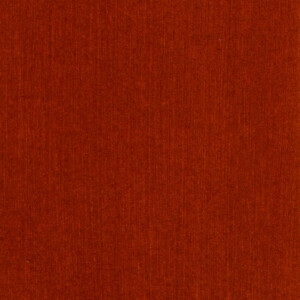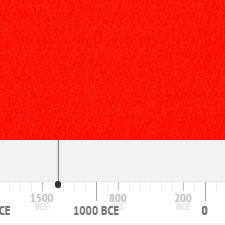Pompeiian Red
Natural inorganic pigmentComposition and Properties of Pompeiian Red
Pompeiian red is actually burnt sienna from Tuscany. The main color giving component of this pigment is iron oxide. It contains around 50% iron oxide and varying amounts of clay and quartz. It is chemically not distinguishable from yellow ochres, the only significant difference being the color. It shows usually darker and warmer tint than the yellow ochres.
Iron oxides are stable at high temperatures but not resistant against acids. The pigment is absolutely stable and is compatible with all other pigments and is often used in mixture with several other pigments.

Pigment

Painted swatch
Names
Alternative names
Light Indian red
Word origin
The name Pompeii is from Oscan pompe “five” (from Proto-Indo-European root *penkwe– “five”), in reference to its five districts
From Online Etymology Dictionary
Pompejanischrot
German
Rouge de Pompéi
French
Rosso pompeiano
Italian
Rojo de Pompeya
Spanish
Preparation of Pompeiian Red
The source of Pompeiian red has been the quarries in Tuscany in Italy. It is produced from the raw material by calcinating (heating) it in order to dehydrate the iron oxide.
History of Use of Pompeiian Red
The frescoes in the villas in Pompeii were painted with this pigment, hence the name. Recent research has shown that the part of the red frescoes might have been originally yellow. Their present red color might be due to the chemical changes of yellow ochre caused by hot gasses emitted before the eruption of Vesuvius (1).
Examples of use
Roman Fresco in the Villa of the Mysteries in Pompeii

Identification of Pompeiian Red
Raman Spectrum
(1) Froment, F., Tournié, A., & Colomban, P., Raman identification of natural red to yellow pigments: ochre and iron-containing ores. Journal of Raman Spectroscopy, 39 (5), (2008) 560–568. doi:10.1002/jrs.1858
References
(1) Kate Helwig, The characterisation of iron earth pigments using infrared spectroscopy, irug.org Postprints p. 83-92.
Further Reading
References
(1) Helwig, K. Iron Oxide Pigments, in Artists’ Pigments, Berrie, B.H., Ed., National Gallery of Art Washington, 2007, pp 38 – 109.
(2) Cornell, R. M., & Schwertmann, U. The Iron Oxides: Structure, Properties, Reactions, Occurrences, and Uses. Wiley 2006.
(3) Earth pigments tour website. It contains a color map of many earth pigments.
(4) Hradil, David; Grygara, Tomáš; Hradilová, Janka; Bezdička, Petr. Clay and iron oxide pigments in the history of painting. Applied Clay Science 22, 2003, p. 230.
(5) Iker Marcaida, Maite Maguregui, Silvia Fdez-Ortiz de Vallejuelo, Juan Manuel Madariaga, Characterization and provenance study of Pompeian red and yellow ochre pigments, Conference paper, Technart 2017.
S. Muntwyler, J. Lipscher, HP. Schneider, Das Farbenbuch, 2nd. Ed., 2023, alataverlag Elsau, pp. 26-27.

